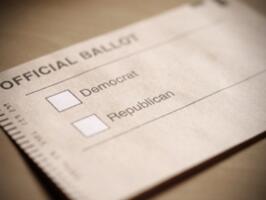What They Told Us: Reviewing Last Week’s Key Polls - Week Ending December 14, 2012
Since Election Day, the number of voters who like the idea of bigger government is up, but most still have the opposite view.
One-in-three Likely U.S. Voters (34%) now prefer a larger government with more services and higher taxes to one with fewer services and lower taxes. That's the highest level of support for bigger government we have ever measured. Most voters (56%), however, still favor smaller government.
Only 37% of voters now say they are conservative when it comes to fiscal issues such as taxes and government spending. That’s the first time that number has ever dipped below 40%. Thirty-nine percent (39%) consider themselves fiscally moderate. One-in-five (20%) now say they are fiscally liberal. More voters than ever describe themselves as socially liberal, too.
However, fiscal conservatives won a big victory last week when Michigan became the 24th right to work state despite angry protests from the president and organized labor. Nationally, voters by a two-to-one margin think right-to-work laws are good for a state economically.
Voters still cherish our nation’s freedoms. Eighty-five percent (85%) think Freedom of Speech is Very Important while 75% say the same about Freedom of Religion. Freedom of the Press and the Right to Bear Arms enjoy less support but are still seen as important.
At the same time, voters are now evenly divided over whether the federal government protects or threatens their constitutional liberties.
There are striking partisan differences on this question, though. Seventy-five percent (75%) of Democrats think the government is a protector of individual rights. The identical percentage (75%) of Republicans and 55% of unaffiliated voters feel the federal government is a threat to those rights. This echoes other surveys that show Democrats like the idea of bigger government a lot more than Republicans and unaffiliated voters do, as Scott Rasmussen explains in a recent radio update.
However, the resistance to the president’s health care law continues to be strong. Scott Rasmussen argues in his latest weekly newspaper column that the law “is still fighting for its life.” While legal and political resistance continues, he explains that “the biggest challenge is more basic. Voters want more control over their own health care choices than either the status quo or the president’s law allows.”
One area of resistance is that only 17 states have agreed to set up their own health insurance exchanges. Policy makers in Washington had assumed that every state would jump on board. That new reality puts a much heavier burden on the federal government. Fewer than half of all voters nationwide want their state to set up its own health care exchange and voters are split as to whether their Governor should help with implementation.
Just 46% of voters have a favorable opinion of the law. As they have from the beginning, voters tend to expect that the law will hurt the quality of care while increasing both the cost of care and federal deficit. Seventy-three percent (73%) think the law is likely to cost more than official estimates.
In addition to skepticism about the health care law, voters continue to overwhelmingly believe that cutting government spending would be good for the economy. This desire for spending cuts comes at a time when 50% of voters are worried the government will not do enough to help the economy. That’s the highest level of support yet measured for government action. Results like these are sometimes used to claim that voters are looking for a bigger government role. However, that is not consistent with the data. In fact, even among those who would like the government to do more, 59% want to see cuts in government spending.
Government spending in America has increased every year since 1954. In his book, The People’s Money, Scott Rasmussen shows how voters are far more willing than their politicians to make fundamental changes in both national security and entitlement spending.
Still, the president has kept targeted spending cuts on the back burner in negotiations to avoid the January 1 “fiscal cliff” of big across-the-board tax hikes and spending cuts and is winning the public relations battle over congressional Republicans. His job approval ratings remain near record highs in the daily Presidential Tracking Poll.
Fifty-two percent (52%) of voters view the auto bailouts as a good move until they’re told the government lost billions bailing out General Motors and Chrysler. Then they’re evenly divided.
In this weekend’s edition of Scott Rasmussen’s new television show, What America Thinks, he talks to conservative activist Grover Norquist whose anti-tax pledge is seen by many in Washington as the big obstacle preventing a fiscal cliff deal. Norquist contends that the pledge will save voters and congressional Republicans form mistakes the GOP has made in the past. Scott is also joined by Emily Tisch Sussman, executive director of Young Democrats of America, and Guy Benson, political editor of TownHall.com, to discuss social issues and the youth vote.
Democrats hold a 10-point lead over Republicans – 46% to 36% - on the Generic Congressional Ballot. This is the fifth week in a row that the Democrats have led on the ballot and the second straight week they have enjoyed a double digit lead.
Consumer and investor confidence changed little following last week’s jobs report but remains just below the highest levels of the past four years.
Thirty-eight percent (38%) believe the US is generally heading in the right direction. That’s down five points from the week leading up to the election but up 19 points from a year ago.
Most Americans remain worried about inflation, and 68% expect to be paying even more for groceries than they are paying now. Fewer than half of Americans remain confident in the stability of the nation's banks.
Win an IPad: Take the Rasmussen Challenge.
In other surveys last week:
-- Voters now think Syria is slightly more likely to use chemical weapons against anti-government rebels, and a plurality continues to believe the United States should help the rebels if those weapons are used.
-- The countdown continues: 12 shopping days left until Christmas, and 32% of Americans still have not begun their holiday gift shopping yet. Twenty-nine percent (29%) are finished.
-- Should Christmas be more about Jesus Christ or Santa Claus? It may seem hard to tell looking at the popular culture, but 76% of Americans believe the holiday should be more about Jesus. Only 14% think Christmas should be more about Santa.
-- Most voters continue to feel America is a fair and decent country and that those who move here need to adopt the prevailing culture.
-- The Senate is quietly discussing legislation to put the federal government in charge of online gambling, freezing out state lotteries that want to move in that direction. But just 34% favor federal government regulation of online gambling.
-- Americans are willing to give up the dollar bill if it would save the government money, and many wouldn’t miss the penny either.
-- Looking back, 36% say 2012 was a good year. That’s not a great assessment, but it’s an improvement over 2011 and Americans have even higher hopes for 2013. LINK
Subscribers to Rasmussen Reports receive more than 20 exclusive stories each week for less than a dollar a week. Please sign up now. Visit the Rasmussen Reports home page for the latest current polling coverage of events in the news. The page is updated several times each day.
Wall Street Journal profile called Scott Rasmussen "America's Insurgent Pollster." The Washington Post described him as "a driving force in American politics." If you'd like Scott to speak at your conference or event, contact Premiere Speakers Bureau.
Remember, if it's in the news, it's in our polls.
Rasmussen Reports is a media company specializing in the collection, publication and distribution of public opinion information.
We conduct public opinion polls on a variety of topics to inform our audience on events in the news and other topics of interest. To ensure editorial control and independence, we pay for the polls ourselves and generate revenue through the sale of subscriptions, sponsorships, and advertising. Nightly polling on politics, business and lifestyle topics provides the content to update the Rasmussen Reports web site many times each day. If it's in the news, it's in our polls. Additionally, the data drives a daily update newsletter and various media outlets across the country.
Some information, including the Rasmussen Reports daily Presidential Tracking Poll and commentaries are available for free to the general public. Subscriptions are available for $4.95 a month or 34.95 a year that provide subscribers with exclusive access to more than 20 stories per week on upcoming elections, consumer confidence, and issues that affect us all. For those who are really into the numbers, Platinum Members can review demographic crosstabs and a full history of our data.
To learn more about our methodology, click here.



